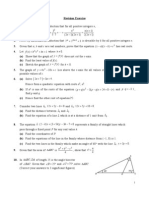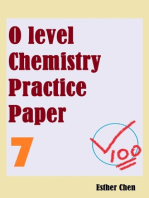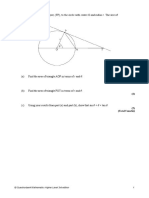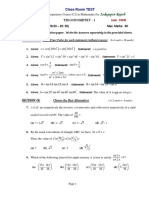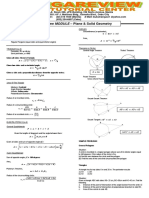Assign Sheet Trig
Uploaded by
Chirag HablaniAssign Sheet Trig
Uploaded by
Chirag HablaniAssignment Sheet Trigonometry
1.
The diagram below shows two straight lines intersecting at O and two circles, each with centre O. The
outer circle has radius R and the inner circle has radius r .
Consider the shaded regions with areas A and B . Given that A: B = 2 :1, find the exact value of the
ratio R : r .
2.
A triangle has sides of length (n2 + n + 1) , (2n +1) and (n2 1) where n > 1.
(a) Explain why the side (n2 + n + 1) must be the longest side of the triangle.
(b) Show that the largest angle, , of the triangle is 120o .
3.
Two non-intersecting circles C1 , containing points M and S , and C2 , containing points N and R, have
centres P and Q where PQ = 50 . The line segments [MN] and [SR] are common tangents to the circles.
The size of the reflex angle MPS is , the size of the obtuse angle NQR is , and the size of the angle
MPQ is . The arc length MS is l1 and the arc length NR is l2 . This information is represented in the
diagram below.
The radius of C1 is x , where x 10 and the radius of C2 is 10.
(a) Explain why x < 40 .
(b) Show that cos = (x 10)/50.
(c) (i) Find an expression for MN in terms of x .
(ii) Find the value of x that maximises MN.
(d) Find an expression in terms of x for
(i) ;
(ii) .
(e) The length of the perimeter is given by l1 + l2 + MN + SR.
(i) Find an expression, b(x), for the length of the perimeter in terms of x .
(ii) Find the maximum value of the length of the perimeter.
(iii) Find the value of x that gives a perimeter of length 200.
4.
In triangle ABC, AB = 9 cm , AC = 12 cm , and angle B is twice the size of angle C .
Find the cosine of angle C.
5.
In the diagram below, AD is perpendicular to BC.
CD = 4, BD = 2 and AD = 3. CAD = and B D A = .
Find the exact value of cos ( ) .
6.
In triangle ABC, BC = a , AC = b , AB = c and [BD] is perpendicular to [AC].
(a) Show that CD = b c cos A.
(b) Hence, by using Pythagoras Theorem in the triangle BCD, prove the cosine rule
for the triangle ABC.
1
3
a b2 a 2
4 .
(c) If AB C = 60o , use the cosine rule to show that c = 2
7.
The above three dimensional diagram shows the points P and Q which are respectively west and southwest of the base R of a vertical flagpole RS on horizontal ground. The angles of elevation of the top S
of the flagpole from P and Q are respectively 35o and 40o , and PQ = 20 m .
Determine the height of the flagpole.
8.
Consider triangle ABC with BAC = 37.8o , AB = 8.75 and BC = 6. Find AC.
9.
The lengths of the sides of a triangle ABC are x 2 , x and x + 2 . The largest angle is 120o .
(a) Find the value of x.
(b) Show that the area of the triangle is 153 / 4.
(c) Find
sin A + sin B + sin C giving your answer in the form pq / r where p, q, r .
10. The diagram below shows a pair of intersecting circles with centres at P and Q with radii of 5 cm and 6
cm respectively. RS is the common chord of both circles and PQ is 7 cm.
Find the area of the shaded region.
11.
Triangle ABC has C = 42o , BC =1.74 cm , and area 1.19 cm2 .
(a) Find AC.
(b) Find AB.
12. The diagram shows a circle centre O and radius 1, with AOB = , 0 . The area of AOB is
three times the shaded area.
Find the value of .
13. The following diagram shows ABC, where BC =105 m, ACB = 40o , ABC = 60o .
Find AB.
14. In the obtuse-angled triangle ABC, AC = 10.9 cm , BC = 8.71 cm and BAC = 50o .
Find the area of triangle ABC.
You might also like
- 2-Math 8-Q3-Week 1-Describing Mathematical System and Illustrating Axiomatic System100% (4)2-Math 8-Q3-Week 1-Describing Mathematical System and Illustrating Axiomatic System54 pages
- Thermal Physics Unit Test High Level Paper 1: Instructions To CandidatesNo ratings yetThermal Physics Unit Test High Level Paper 1: Instructions To Candidates10 pages
- (Total 1 Mark) : IB Questionbank Physics 1No ratings yet(Total 1 Mark) : IB Questionbank Physics 18 pages
- Shapes of Molecules Ions (Further Practice) QPNo ratings yetShapes of Molecules Ions (Further Practice) QP10 pages
- Exam Physics IB Measurement and Uncertainties 2No ratings yetExam Physics IB Measurement and Uncertainties 25 pages
- Math AIHL Summer Holiday Homework 2022, MS, IB 1No ratings yetMath AIHL Summer Holiday Homework 2022, MS, IB 116 pages
- Standard Mathematics Assessment - 3 - Copy 22RPXK With MarkschemeNo ratings yetStandard Mathematics Assessment - 3 - Copy 22RPXK With Markscheme33 pages
- Test1 SLHL Exp Log Functns v1 (COMPLETED)No ratings yetTest1 SLHL Exp Log Functns v1 (COMPLETED)9 pages
- IB Internal Assessment Guide 08 - PhysicsNo ratings yetIB Internal Assessment Guide 08 - Physics13 pages
- 2017 H2 Prelim (Graphs and Transformations)No ratings yet2017 H2 Prelim (Graphs and Transformations)21 pages
- Mathematics: Applications and Interpretation Standard Level Paper 2No ratings yetMathematics: Applications and Interpretation Standard Level Paper 27 pages
- Practice - Mean, Median, Mode, Range June27No ratings yetPractice - Mean, Median, Mode, Range June272 pages
- Complex Numbers PPQs Paper 1 MARKSCHEMENo ratings yetComplex Numbers PPQs Paper 1 MARKSCHEME19 pages
- Pythagoras' Theorem Worksheet #01, Shape & Space Revision From GCSE Maths TutorNo ratings yetPythagoras' Theorem Worksheet #01, Shape & Space Revision From GCSE Maths Tutor2 pages
- SL Topic 2: Atomic Structure: © DR Geoffrey Neuss, InthinkingNo ratings yetSL Topic 2: Atomic Structure: © DR Geoffrey Neuss, Inthinking8 pages
- 4016 Mathematics Topic 1: Numbers and AlgebraNo ratings yet4016 Mathematics Topic 1: Numbers and Algebra7 pages
- Extended - Mathematics - Markscheme May 2016No ratings yetExtended - Mathematics - Markscheme May 201624 pages
- (MAA 5.4) TANGENT AND NORMAL LINES - EcoNo ratings yet(MAA 5.4) TANGENT AND NORMAL LINES - Eco8 pages
- IB Questionbank Mathematics Higher Level 3rd Edition 1No ratings yetIB Questionbank Mathematics Higher Level 3rd Edition 15 pages
- Climate Responsive Architecture Creating Greater Design Awareness Among Architects PDF100% (1)Climate Responsive Architecture Creating Greater Design Awareness Among Architects PDF11 pages
- Logarithms Practice Questions: Attempt These Questions Without A CalculatorNo ratings yetLogarithms Practice Questions: Attempt These Questions Without A Calculator1 page
- 6th G M Tex Book Ratio Proportions. Percentage Pages 364 - 401No ratings yet6th G M Tex Book Ratio Proportions. Percentage Pages 364 - 40138 pages
- Calculus With Analytic Geometry (PDFDrive)No ratings yetCalculus With Analytic Geometry (PDFDrive)931 pages
- CRT - TRIGONOMETRY - 1 Dated 09.09.2014 by Sadagopan RajeshNo ratings yetCRT - TRIGONOMETRY - 1 Dated 09.09.2014 by Sadagopan Rajesh3 pages
- Dokumen - Tips - A Detailed Lesson Plan in Mathematics Vivolume of Rectangular PrismNo ratings yetDokumen - Tips - A Detailed Lesson Plan in Mathematics Vivolume of Rectangular Prism9 pages
- Lesson 4 Derivative of Algebraic FunctionsNo ratings yetLesson 4 Derivative of Algebraic Functions17 pages
- Squares, Square Roots, Cubes and Cube RootsNo ratings yetSquares, Square Roots, Cubes and Cube Roots14 pages
- As Level Mathematics Unit1 Question Paper Jun19No ratings yetAs Level Mathematics Unit1 Question Paper Jun1928 pages
- Review Module 5 Plane and Solid Geometry Part 1100% (1)Review Module 5 Plane and Solid Geometry Part 12 pages









